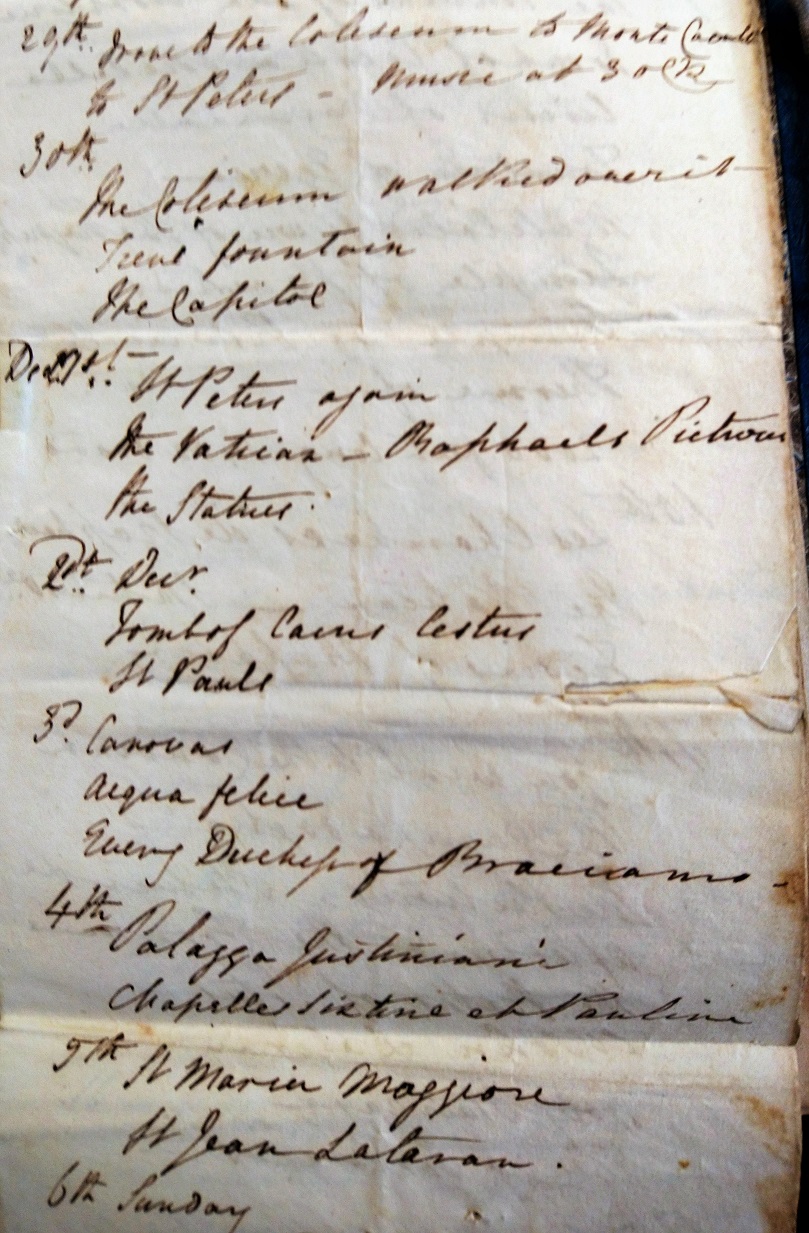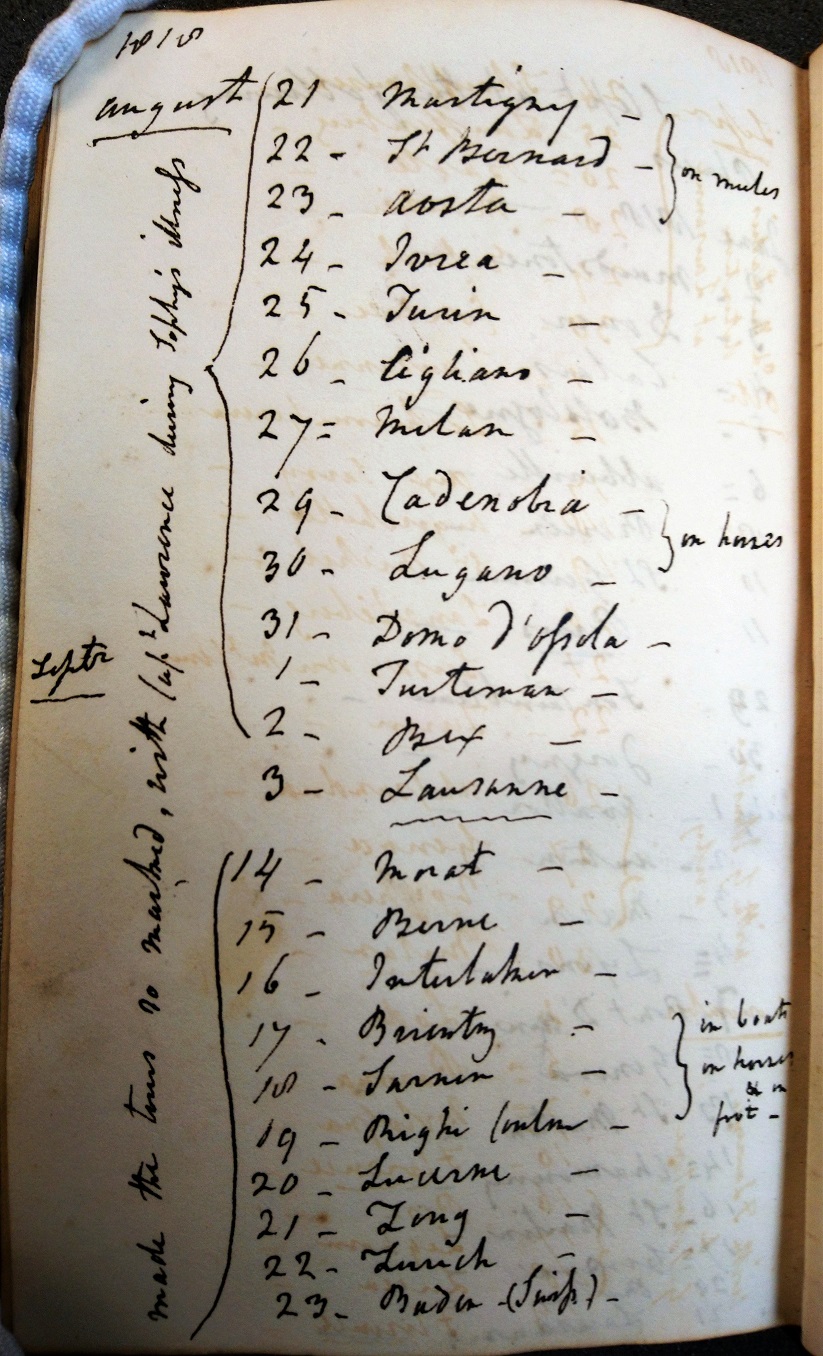Guest post by Katherine Knight
Summer intern at Bodleian Libraries Archives & Modern Manuscripts
Many of us today may be tempted to keep some kind of record of our holidays: but very rarely do we imagine they will survive for another two-hundred years. Thomas Kirkpatrick (‘T.K.’) Hall (1776-1865) and his wife Elizabeth, née Crompton, did the same as many of the English wealthy in the 19th century: they commenced their own ‘Grand Tour’ of Europe. Passing through Kent to France, Switzerland, and Italy, the couple spent thirteen months from the years 1818-1819 touring the continent, and recorded their individual experiences in seven volumes.

Leaving London on 2 June 1818: The first page of Thomas K. Hall’s diary, and the beginning of a journey.
Interestingly, the two appear to have had very different approaches to how to keep their respective journals. While Eliza Hall kept a mostly meticulous account of her travels, with detail given to the activities of each day, she did find that in busy times she got somewhat carried away with the excitement of travelling – as many of us do with our own attempts to journal. When in Rome, she listed the places visited on each day without description, with the details evidently added afterwards from other records.

When in Rome, see all the sights: A tourist’s busy cultural and social schedule in December 1818. The diary also mentions the Halls meeting Lord Byron in or near Rome.
It is here that having a dual account proves invaluable, as T.K. Hall filled in the details of what was missed with elaborate strokes. While in awe of the wonders of St Peter’s Basilica, he was not, however, impressed that there were no special services on Christmas Day – and, even more surprisingly, believed the Sistine Chapel did not live up to expectations!
This temporary lapse in narrative is surprising, as otherwise Eliza’s narrative is meticulous. Her journal is kept in three blue-bound hardback volumes and is immensely detailed.

‘So large an English congregation so far from home’ – church service in Geneva, as described by Eliza Hall [July 1818].

From ‘very bad’ to ‘excellent’: Thomas K. Hall’s hotel ratings. How many points out of 10 would equal ‘tolerable’ or ‘indifferent’?
Nevertheless, there are several similarities between the style of the two works, right down to the list of towns and distances between which can be found pasted into the covers of each journal. It is tempting to picture the two discussing their journeys, calculating the distances between and making a meticulous log together. Fittingly, both end on the same phrase: thanking God for preserving them on their pleasant journey through the continent.
In a time before travel photography, it is particularly interesting to see a different kind of holiday picture: two volumes of watercolours and sketches by Eliza Hall of various places around Europe. And the landscapes were continued beyond the pair’s brief holiday: the sketches continue through the years, with landscapes of Wales contained amongst the European memories.
We have some details of the lives of the Halls – like many at the time, they came from a legacy of sugar plantation ownership. It makes for uncomfortable reading today, but is perhaps not surprising when one considers the expense required to embark upon a thirteen-month journey around the continent. The records of life of the Victorian participants of the Grand Tour must inevitably be laid against the background of such sources of income: indeed, it continues to be the foundation of much wealth even today.
– Katherine Knight, University College
Oxford University Careers Service Summer Internship Programme
The late 1810s and 1820s seem to have been popular time for doing the ‘Grand Tour’: Just as the Halls, Thomas FitzGerald (1788-1860) set out on travel France and Switzerland in 1818/1819, and he returned to the Continent for a combination of tourism and studies in Italy in 1822/1823. His travel diaries and notes are now in the family papers series of the archive of his granddaughter, the scientist Mabel Purefoy FitzGerald (MS. Mabel FitzGerald 81).




